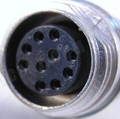| Pin | N1. Common black and white portapak camera |
N2. Common colour portapak camera |
N3. 1980s/1990s Panasonic colour portapak camera wiring |
N4. JVC colour portapak camera |
CCJ cable wires |
|---|---|---|---|---|---|
| 1 | Camera Video out | Video coax core (largest coax) | |||
| 2 | Video gnd | Shield for pin 1 | |||
| 3 | Vertical sync | often unused | Serial data | Line view/ tape playback |
Shielded wire |
| 4 | Shield for pins 3 and 5 | Shield for pins 3 and 5 | Serial clock | Shield for pins 3 and 5 | Shield for pins 3 and 5 |
| 5 | Horizontal sync | Right channel audio (if stereo) |
standby out (steady +5v or 0v) |
Audio return / |
Coax core (thinner coax) |
| 6 | Record stop/start | Record stop/start | Record stop/start (momentary +9v/0v) |
Record stop/start | Unshielded wire |
| 7 | Audio out | Camera audio (left channel if stereo) |
Camera audio | Camera audio | Shielded wire |
| 8 | Audio gnd | Shield for pin 7 | |||
| 9 | Power gnd | Ground wire | |||
| 10 | +12V DC power | Unshielded wire | |||
Notes for pinouts sets:
N1. A 1970s B&W Panasonic WV-85, and many others, used this wiring. Although there's plenty of other variations.
N1.-N4.: The microphone is usually amplified, but still at the usual microphone levels. VTR playback re-uses pin 1, with a few volts DC on top (as a mode switching signal).
This pinout, with option N1 works for the Canon VS-30. The pinouts are for the MALE end of the cable that is permanently installed in the camcorder.
Note for CCJ cable: All shields are isolated from each other, other than the two that join on pin 4. There may be a shield around all the wiring in the cable, this may be joined to the pin 9 ground.
Some device-specific pinouts:
Panasonic WV-341N B&W camera wiring, 1970s vintage
- Camera video
- Shield for pin 1
- Vertical sync
- Shield for pins 3 and 5
- Horizontal sync
- Tally lamp
- Intercom audio (tip)
- Intercom audio (ring)
- Line view video
- Tally lamp
Two 24 volt tally lamps are directly wired across pins 6 & 10, the top and rear tally lamps, in parallel. The intercom line is wired directly to the tip and ring of the ¼ inch TRS jack, with a 3 volt (if I recall correctly) baristor from tip to sleeve. The intercom is totally isolated from the rest of the camera, ground, and the chassis. The intercom headset has a 35Ω carbon mike between tip and sleeve, and a 160Ω earpiece between ring and sleeve. The camera is separately mains powered.
Panasonic WV-3200N single-tube colour camera, 1980s vintage
- Camera video / playback video (with +5 volts DC on top)
- Shield for pin 1
- Not connected
- Grounded
- +3.2 volts standby / 0 volts operate
- Record (+5 volts) start / stop (0 volts)
- Camera audio
- Shield for pin 7
- Power ground
- +12 volts DC
Directly usable with the NV-100 portapak VCR.
Panasonic NV100 portable VCR, 1980s vintage
- Camera video / playback video (with +5 volts DC on top)
- Shield for pin 1
- +4 volts
- Grounded
- +3.2 volts standby / 0 volts operate
- Record (+5 volts) start / stop (0 volts)
- Camera audio
- Shield for pin 7
- Power ground
- +12 volts DC
If video is present on pin 1, record/pause control is from the camera. Otherwise, the pause button on the VTR is used.
Panasonic WV-3600N single-tube colour camera, 1980s vintage
- Camera video
- Shield for pin 1
- Line view video, and tally signal (DC added to the video)
- Shield for pins 3 and 5
- Genlock video in RCU mode, something else (but unknown) in VTR mode
- Pedestal control in RCU mode, record start/stop in VTR mode
- Presumed intercom in RCU mode, and camera audio in VTR mode
- Shield for pin 7
- Power ground
- +12 volts DC
Directly usable with the NV-100 portapak VCR.



 correct
correct incorrect
incorrect